The Five Steps of the Sales Process
- Prospect
- Qualify
- Research/Evaluate
- Present
- Close
1. Prospect
Prospecting, also known as lead generation, is the process of finding potential buyers to add to the top of the sales funnel. This may include people who have expressed an interest in your product or service, or appear to be a good match based on demographics or a buyer persona.
It’s a good idea to do some market research on your competition. You can use that information to provide your prospects with some benefits your competitors are lacking.
2. Qualify
Before anyone on the sales team can dive into the sales process with a potential buyer, make sure they are a good fit. Time is precious and you don’t want to waste any if they aren’t serious or don’t have the authority to make important purchasing decisions. For example, when a husband is making a big purchasing decision, he should probably stop and consult with his wife before proceeding any further.
3. Research/Evaluate
When it’s determined that you and a customer appear to be a good fit, doing some additional research will help you better meet their needs and possibly even be able to offer them something before they are even aware that they want or need it.
4. Present
The next step in the sales process is to demonstrate or present your product to the buyer. This is usually done as a formal presentation, so there is a bit of prep work that needs to take place prior to flashing your product on the main stage. Be prepared to not only demonstrate your product in detail, but answer technical questions too.
5. Close
To close a sale by coming to a contractual sales agreement should be the main goal of every salesperson. This is where you deliver the proposal, make any final negotiations, and get them to sign on the dotted line. Hopefully by the end of this process, they have morphed from potential to actual customer.
The sales presentation should be tailored or customized to your buyer, meaning you wouldn’t introduce a bacon wrapped steak to a vegetarian.


